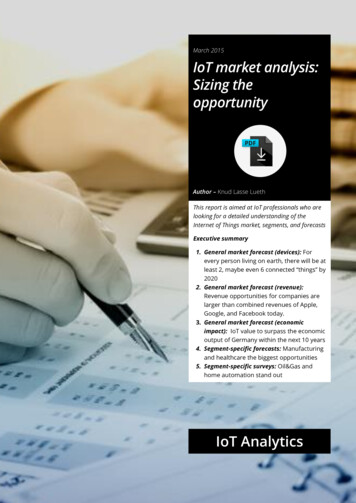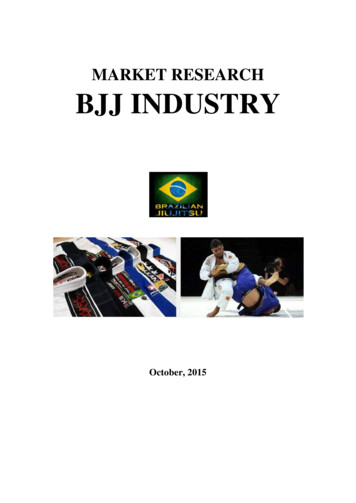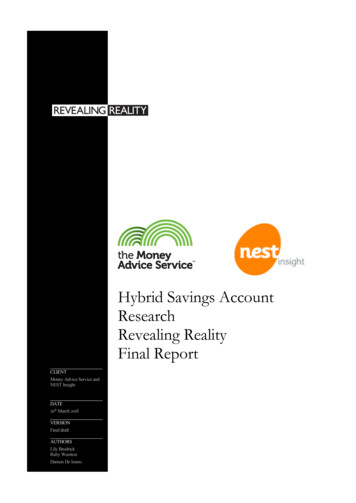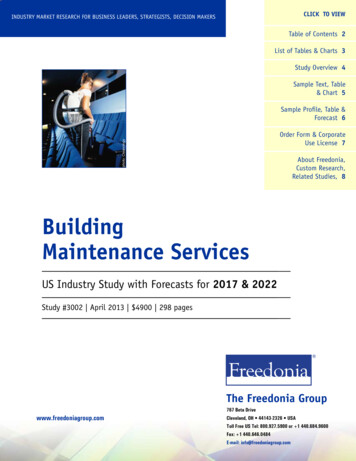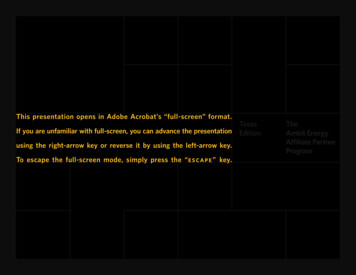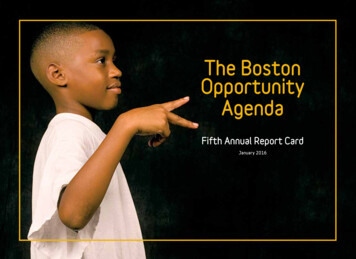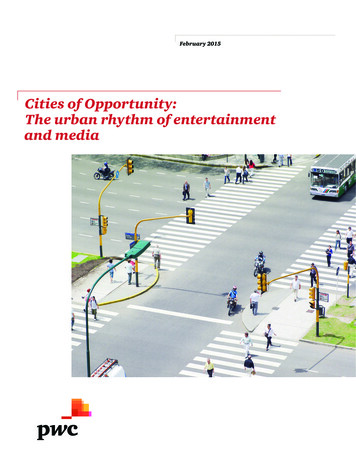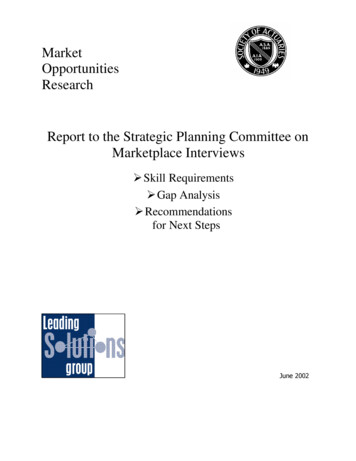
Transcription
MarketOpportunitiesResearchReport to the Strategic Planning Committee onMarketplace InterviewsØ Skill RequirementsØ Gap AnalysisØ Recommendationsfor Next StepsJune 2002
Society of Actuaries - Market Opportunities ResearchSPC Version – Report on Marketplace InterviewsTable of ContentsEXECUTIVE SUMMARY.1Summary of Recommended Next Steps. 2REPORT ON MARKETPLACE INTERVIEWS FOR THE SOA STRATEGIC PLANNING COMMITTEE.3IMPACT ON THE SOA’S STRATEGY .3RECOMMENDED UPDATES TO STRATEGIC PLAN . 3Market- and Member-Focus. 4“Broader, Deeper and Stronger” Strategies . 6W HAT ELSE DOES THE DATA TELL US THAT THE SOA CAN PUT TO USE? . 7Measurements: Balanced Scorecard Implications from the Market Research . 7Questions for Consideration. 8MOR RESULTS: OVERVIEW OF BACKGROUND AND METHODOLOGY. 10KEY FINDINGS . 11What is Changing, and What’s Driving the Change. 11Marketplace Forces. 12Collective Impacts of the Forces . 12Key Strategic Responses. 13Key Findings about Skill Sets. 13ADDITIONAL CHARTS. 16APPENDICES . 18A PPENDIX A – RELEVANT STRATEGIC INITIATIVES FROM THE SOA 2001 STRATEGIC PLAN . 19A PPENDIX B – LIST OF FIRMS INTERVIEWED BY MARKET SEGMENT . 20A PPENDIX C – SECONDARY MARKET RESEARCH SOURCES, INTERNAL SOA DOCUMENTS, AND W EB SITES . 21Other Resources and Reports. 21Internal SOA Documents. 21Web Sites. 21A PPENDIX D – M ARKETPLACE EMPLOYERS INTERVIEW PROTOCOL. 22A PPENDIX E – SKILL SET GRADIENT DEFINITIONS. 29A PPENDIX F – BUSINESS SAVVY SKILL SET DEFINITIONS . 32A PPENDIX G – BACKGROUND AND M ETHODOLOGY . 33Background. 33Market Segments. 33Summary of Deliverables . 34Methodology. 35Interviewees . 36A PPENDIX H – M ARKET OPPORTUNITIES RESEARCH PROJECT DELIVERABLES BY STAGE . 38A PPENDIX I – TABULATED INTERVIEWEE COUNTS BY M ARKET AND SEGMENT . 40A PPENDIX J -- THE SOA BOARD OF GOVERNORS STRATEGY HOUSE . 41Copyright 2002 Leading Solutions Groupii
Society of Actuaries - Market Opportunities ResearchSPC Version – Report on Marketplace InterviewExecutive SummaryMost Important Strategic Implications from this ResearchThis Market Opportunities Research (MOR) Project builds upon the foundation created at theSOA Strategic Planning Retreat in November 2000. The momentum for the MOR came from theStrategic Plan, drafted at that retreat and approved by the Board of Governors in March 2001.The most important strategic implications from the MOR follow:A. Both the Retreat and the resulting Strategic Plan focus on the right issues: forces in themarketplace are changing both what customers need and the landscape of financial services.Actuaries and other business professionals with actuarial- like skills have key roles to play inmanaging the risk attendant to the strategic response to these changes.B. Employers in the marketplace do seek people with the quantitative skills. Indeed they want afew highly skilled quantitative analysts in every firm. However, they want the vast majority ofrisk analysis and risk problem-solving experts to have a slightly lesser degree of quantitativeskill than an actuary, combined with broad creative business savvy. They want people who cansee what issues really matter, apply their analytical abilities to those strategic issues, and thendevise creative solutions – and most critically – explain the solutions concisely and clearly toexecutives and customers.C. The challenge for the SOA and the actuarial profession is that employers, even traditionalemployers of actuaries, perceive that very few actuaries have both the quantitative skill and thebusiness savvy to analyze situations, and then create common sense strategic solutions that areeasily communicated to all target audiences.D. The SOA’s Strategic Plan takes the Society and the profession down the right pathways:without eroding the esteem of the ASA or FSA. The SOA should attune the skills behind thesecredentials to better parallel the needs of the marketplace. To build upon and compliment thehistorical reputation of its members, the SOA should offer a new credential, a kind of hybrid ofan ASA, and MBA and a CFA. The SOA should offer this new credential, as outlined in theRetreat discussion and pursued in the Strategic Plan. It should do this because this approachwill do more in a shorter time than anything else to significantly change the market’s perceptionof actuaries, who they are, and what they can do.Key Findings: Market Forces and TrendsThe data gathered from multiple methods and sources include these conclusions aboutmarkets:1. Market and societal forces have been driving change, and will continue to drive change, to thebusiness strategies in financial services. Chief among these forces are demography,technology (both information and biomedical), regulatory changes, and market globalization.2. The most significant strategic responses to these drivers will involve the design of productbundles across traditional financial services lines of business. These bundles will be tailoredand even customized to the needs of individual consumers, then marketed, sold and servicedthrough both high tech and high touch distribution channels.Copyright 2002 Leading Solutions Group1
Society of Actuaries - Market Opportunities ResearchSPC Version – Report on Marketplace InterviewKey Findings: Skills the Market Desires3. When employers hire people to help assess, anticipate, and manage business risk, both thetraditional and broader financial services market employers put the most importance on theseskill sets: Quantitative Analysis Assess & Manage Risk Creative Business Savvy (See Appendix F for a description of these skills.)4. The level of quantitative skills that the traditional and broader financial services marketsdesire is about the same. It includes the calculus; multivariate statistics based on the generallinear model and the calculus; plus skillful multivariate modeling, but not to the level ofcalculus based statistical modeling. (See Appendix E – The Skill Sets Gradients for moredetails.)5. Practice Areas within the traditional employment marketplace desire different levels of specificskills (Quantitative, Accounting, Financial Institutions & Markets, Economics, and Assess &Manage Risk) depending upon the nature of their work. (See Appendix – E and the AdditionalCharts provided at the end of the main body of the report.)6. Among the Creative Business Savvy skills, the two most important skill sets are: Business Communication – succinctly, persuasively, and clearly communicate businessanalyses and recommended solutions/innovations to customers and seniormanagement/boards of directors. Business Acumen – broad-based knowledge and ability to apply business disciplines, usedto grasp the whole of a problem or situation and develop creative, implementablesolutions.Summary of Recommended Next StepsAt a strategic level, the SOA should strongly consider these actions:A. Align the education and qualifications requirements to more closely match themarketplace’s desires.B. Offer at least one new credential, focusing on the skill sets desired by the BroaderFinancial Service Markets (banks, “The Street,” and financial consulting firms), andopenly explore doing that jointly as a strategic partner with one or two otherprofessional organizations (AMIR, AICPA, IAFE ).This credential could provide expanded employment opportunities in traditional markets, asmore companies expand from traditional insurance products to a broader array of bundledinvestment products and financial services. Such a credential will position actuaries as optimalcandidates for this work.C. Work swiftly and diligently to change the perception of actuaries as onedimensional insurance-sector professionals. This would be accomplished on twofronts.1) Impart the creative business savvy skill set to all members and students through thedeployment of targeted innovations in the continuing education offered by SOA, as well asother strategic and tactical means outlined in the Strategic Plan.Copyright 2002 Leading Solutions Group2
Society of Actuaries - Market Opportunities ResearchSPC Version – Report on Marketplace Interview2) Educate members and students, as well as employers and prospective employers, aboutthe actions being taken to equip all actuaries with additional competencies. Thiseducation should be delivered through multiple communication channels.D. Create a better feedback loop to improve alignment of education andqualifications requirements leading to SOA credentials with the skill setsemployers need, in both the traditional and broader financial servicesmarketplaces. This feedback loop should employ a multi-method, multi-source approach togathering feedback from business leaders whose firms employ actuaries and other kinds ofrisk analysis and management professionals. These business leaders should represent both:a) Those that manage actuarial and risk management functions; and,b) Those that rely upon the outputs from those functions to establish businessstrategy and implement business solutions.The remainder of this report provides the detail behind the Executive Summary.Report on Marketplace Interviews for the SOA Strategic PlanningCommitteeThe sections in this report appear in order of their importance for strategic thinking, rather thanthe classic research report sequence of method-findings-conclusions. The first section discussesthe impact of the research on the Society’s strategic planning and targeted strategic goals.Following that section is an outline of the methodology (detailed in Appendix G – Backgroundand Methodology), and the specific findings from the research.Impact on the SOA’s StrategyThe SOA Strategic Plan, approved in March 2001 by the Board of Governors, began at aStrategic Planning Retreat in November 2000. Both the Retreat and the Strategic Planidentified these phenomena:v Forces in the global economy and the financial services marketplace have createdtrends, which will continue into the for
marketplace are changing both what customers need and the landscape of financial services. Actuaries and other business professionals with actuarial-like skills have key roles to play in managing the risk attendant to the strategic response to these changes. B. Employers in the marketplace do seek people with the quantitative skills. Indeed .
